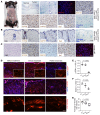Humanized neurofibroma model from induced pluripotent stem cells delineates tumor pathogenesis and developmental origins
- PMID: 33108355
- PMCID: PMC7773354
- DOI: 10.1172/JCI139807
Humanized neurofibroma model from induced pluripotent stem cells delineates tumor pathogenesis and developmental origins
Erratum in
-
Corrigendum for Humanized neurofibroma model from induced pluripotent stem cells delineates tumor pathogenesis and developmental origins.J Clin Invest. 2025 Oct 15;135(20):e199700. doi: 10.1172/JCI199700. eCollection 2025 Oct 15. J Clin Invest. 2025. PMID: 41090364 Free PMC article. No abstract available.
Abstract
Neurofibromatosis type 1 (NF1) is a common tumor predisposition syndrome caused by NF1 gene mutation, in which affected patients develop Schwann cell lineage peripheral nerve sheath tumors (neurofibromas). To investigate human neurofibroma pathogenesis, we differentiated a series of isogenic, patient-specific NF1-mutant human induced pluripotent stem cells (hiPSCs) into Schwannian lineage cells (SLCs). We found that, although WT and heterozygous NF1-mutant hiPSCs-SLCs did not form tumors following mouse sciatic nerve implantation, NF1-null SLCs formed bona fide neurofibromas with high levels of SOX10 expression. To confirm that SOX10+ SLCs contained the cells of origin for neurofibromas, both Nf1 alleles were inactivated in mouse Sox10+ cells, leading to classic nodular cutaneous and plexiform neurofibroma formation that completely recapitulated their human counterparts. Moreover, we discovered that NF1 loss impaired Schwann cell differentiation by inducing a persistent stem-like state to expand the pool of progenitors required to initiate tumor formation, indicating that, in addition to regulating MAPK-mediated cell growth, NF1 loss also altered Schwann cell differentiation to promote neurofibroma development. Taken together, we established a complementary humanized neurofibroma explant and, to our knowledge, first-in-kind genetically engineered nodular cutaneous neurofibroma mouse models that delineate neurofibroma pathogenesis amenable to future therapeutic target discovery and evaluation.
Keywords: Neurological disorders; Neuroscience; Oncology; Tumor suppressors.
Conflict of interest statement
Figures








References
Publication types
MeSH terms
Substances
Grants and funding
LinkOut - more resources
Full Text Sources
Other Literature Sources
Research Materials
Miscellaneous

